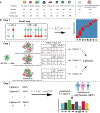A Cancer-Specific Qualitative Method for Estimating the Proportion of Tumor-Infiltrating Immune Cells
- PMID: 34054849
- PMCID: PMC8160514
- DOI: 10.3389/fimmu.2021.672031
A Cancer-Specific Qualitative Method for Estimating the Proportion of Tumor-Infiltrating Immune Cells
Abstract
Tumor-infiltrating immune cells are important components in the tumor microenvironment (TME) and different types of these cells exert different effects on tumor development and progression; these effects depend upon the type of cancer involved. Several methods have been developed for estimating the proportion of immune cells using bulk transcriptome data. However, there is a distinct lack of methods that are capable of predicting the immune contexture in specific types of cancer. Furthermore, the existing methods are based on absolute gene expression and are susceptible to experimental batch effects, thus resulting in incomparability across different datasets. In this study, we considered two common neoplasms as examples (colorectal cancer [CRC] and melanoma) and introduced the Tumor-infiltrating Immune Cell Proportion Estimator (TICPE), a cancer-specific qualitative method for estimating the proportion of tumor-infiltrating immune cells. The TICPE was based on the relative expression orderings (REOs) of gene pairs within a sample and is notably insensitive to batch effects. Performance evaluation using public expression data with mRNA mixtures, single-cell RNA-Seq (scRNA-Seq) data, immunohistochemistry data, and simulated bulk RNA-seq samples, indicated that the TICPE can estimate the proportion of immune cells with levels of accuracy that are clearly superior to other methods. Furthermore, we showed that the TICPE could effectively detect prognostic signals in patients with tumors and changes in the fractions of immune cells during immunotherapy in melanoma. In conclusion, our work presented a unique novel method, TICPE, to estimate the proportion of immune cells in specific cancer types and explore the effect of the infiltration of immune cells on the efficacy of immunotherapy and the prognosis of cancer. The source code for TICPE is available at https://github.com/huitingxiao/TICPE.
Keywords: immunotherapy; prognosis; relative expression orderings; signature genes; tumor microenvironment.
Copyright © 2021 Xiao, Zhang, Wang, Song, Zheng, Yang, Li, Yuan, Zhao and Hui.
Conflict of interest statement
The authors declare that the research was conducted in the absence of any commercial or financial relationships that could be construed as a potential conflict of interest.
Figures





Similar articles
-
ProTICS reveals prognostic impact of tumor infiltrating immune cells in different molecular subtypes.Brief Bioinform. 2021 Nov 5;22(6):bbab164. doi: 10.1093/bib/bbab164. Brief Bioinform. 2021. PMID: 33963834
-
Unveiling the immune microenvironment of complex tissues and tumors in transcriptomics through a deconvolution approach.BMC Cancer. 2025 May 1;25(Suppl 1):733. doi: 10.1186/s12885-025-14089-w. BMC Cancer. 2025. PMID: 40307726 Free PMC article.
-
Immune Infiltrating Cells-Derived Risk Signature Based on Large-scale Analysis Defines Immune Landscape and Predicts Immunotherapy Responses in Glioma Tumor Microenvironment.Front Immunol. 2021 Aug 13;12:691811. doi: 10.3389/fimmu.2021.691811. eCollection 2021. Front Immunol. 2021. PMID: 34489938 Free PMC article.
-
Cancer immune contexture and immunotherapy.Curr Opin Immunol. 2016 Apr;39:7-13. doi: 10.1016/j.coi.2015.11.009. Epub 2015 Dec 17. Curr Opin Immunol. 2016. PMID: 26708937 Review.
-
The history and advances in cancer immunotherapy: understanding the characteristics of tumor-infiltrating immune cells and their therapeutic implications.Cell Mol Immunol. 2020 Aug;17(8):807-821. doi: 10.1038/s41423-020-0488-6. Epub 2020 Jul 1. Cell Mol Immunol. 2020. PMID: 32612154 Free PMC article. Review.
Cited by
-
DeepDecon accurately estimates cancer cell fractions in bulk RNA-seq data.Patterns (N Y). 2024 Apr 15;5(5):100969. doi: 10.1016/j.patter.2024.100969. eCollection 2024 May 10. Patterns (N Y). 2024. PMID: 38800361 Free PMC article.
-
Computational identification and clinical validation of a novel risk signature based on coagulation-related lncRNAs for predicting prognosis, immunotherapy response, and chemosensitivity in colorectal cancer patients.Front Immunol. 2023 Oct 19;14:1279789. doi: 10.3389/fimmu.2023.1279789. eCollection 2023. Front Immunol. 2023. PMID: 37928532 Free PMC article.
-
Fourteen years of cellular deconvolution: methodology, applications, technical evaluation and outstanding challenges.Nucleic Acids Res. 2024 May 22;52(9):4761-4783. doi: 10.1093/nar/gkae267. Nucleic Acids Res. 2024. PMID: 38619038 Free PMC article. Review.
References
Publication types
MeSH terms
LinkOut - more resources
Full Text Sources
Other Literature Sources
Medical

